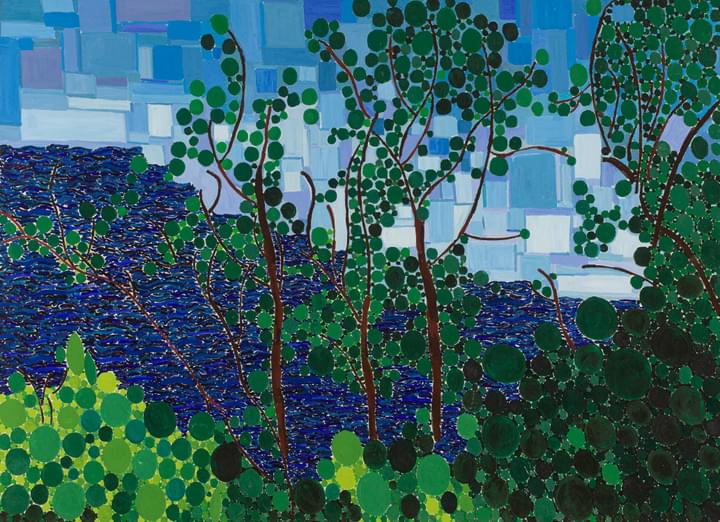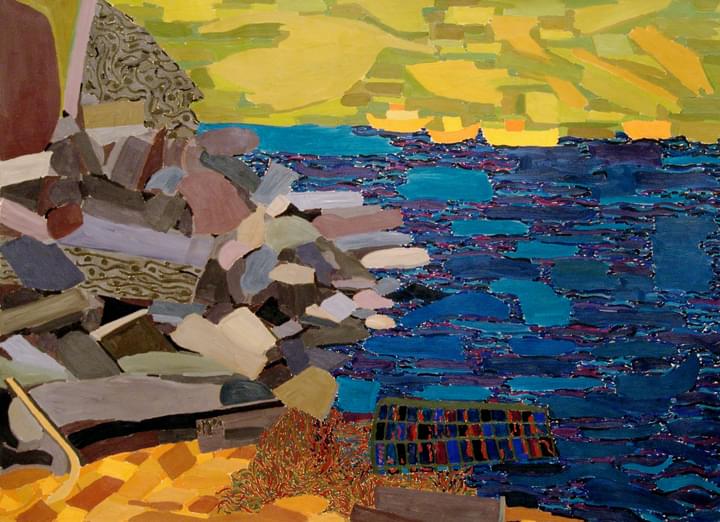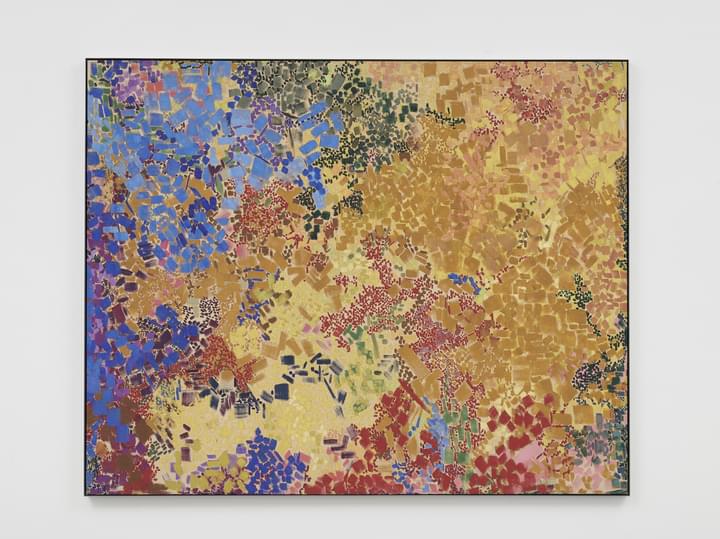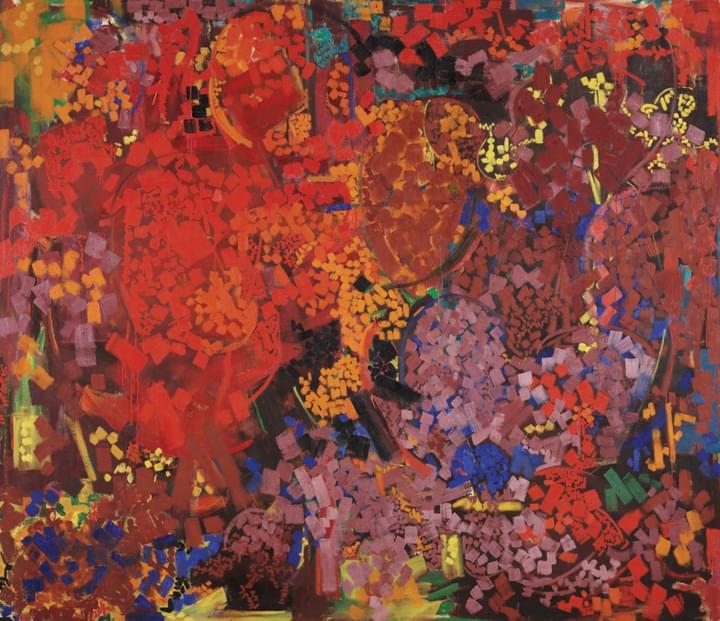Born in 1928 near Newport News, Virginia, in early childhood Drexler demonstrated a precocious aptitude for painting. Nurtured and encouraged by her parents and teachers, she pursued a formal art education, enrolling in painting classes at various institutions across Virginia. Following two extended sojourns to Europe in the early 1950s, Drexler made the pivotal move to New York in 1955, immersing herself in a vibrant and tumultuous art scene where a new vanguard of Abstract Expressionists was reshaping the cultural landscape. In New York, Drexler studied under the tutelage of two leading proponents of the movement: first with Hofmann at his New York and Provincetown summer school, and later with Robert Motherwell at Hunter College. Through their teaching, Drexler was introduced to the formal principles of abstract art, developing a foundational understanding of ways to push form, colour and space within her canvases.
In Drexler’s early works, one can discern the origins of her short, intersecting brushstrokes, with gestural echoes of Abstract Expressionism.
Gotterdammerung (1959), titled after Wagner’s operatic sequence, possesses a mosaic-like intricacy, with unruly accretions of rectangular forms flocking the picture plane, colliding with the immediacy of impasto layering and drips. A later painting,
Deep Run (1963), takes on a more geometric direction with elongated striations of purple, yellow and viridian green to isolate the stippled particles of pigment. Echoes of Klimt’s
Bauerngarten (1907) manifest in the pointillist techniques and botanical allusions of
Flowered Hundred (1962), while traces of Van Gogh can be read in the swirling vortices of colour that compose
A Blossom (1967). Drexler’s works from this decade trace the path of an artist trialling and refining various modes of painting, endeavouring to forge a distinctive artistic vocabulary.
Drexler met the painter John Hultberg at an Artists’ Club party in 1961, and the two married later that year. They established a base in Los Angeles in 1963, where Drexler created a series of lithographs at the Tamarind Lithography Workshop, many of which would be acquired by prominent museums including the MoMA, New York, and the National Gallery of Art, Washington, DC. Later that year, they relocated to Mexico, exhibiting jointly at Galleria in San Miguel. Returning to the United States in 1964, they temporarily settled in Portland, Maine, where Hultberg served as artist-in-residence at the Portland Art Museum, then moving to San Francisco and Honolulu for various teaching positions, before returning to New York in 1967, where they took residence in the Chelsea Hotel – a mecca for artists during that period.
By the mid- to late-1960s, the dominant position of Abstract Expressionism was entering a decline, ceding ground to the emerging Pop Art movement in New York. Concurrently, Drexler’s own work was developing away from an AE vocabulary, arriving at her distinctive, more lyrical style in a series of abstract paintings influenced by the landscape. In 1963, Drexler purchased a house with Hultberg on Monhegan Island, off the coast of Maine, utilising it during the summers to escape the bustling social scene in the city.
In 1983, Drexler separated from her husband and made a permanent move to the island, remaining there until her death in 1999. The move marked a period of creative transition for Drexler, during which her signature vocabulary of abstract mark-making underwent a transformation, shifting towards a visual language that welcomed trace elements of the island’s dramatic and rugged coastal surroundings, including the coastal landscape and flora of the region. In her later years, Drexler found local renown, exhibiting in galleries on the island and nearby mainland, coalescing a picture of an artist who, despite the shifting currents of the art world, never ceased to create.
Lynne Drexler (1928–99) was born in Newport News, Virginia, and lived and worked in New York City and Monhegan Island, Maine. Her solo exhibitions include Berry Campbell, New York (2022); Mnuchin Gallery, New York (2022); Anita Shapolsky Gallery, New York (2022, 2007, 2002, 1987 and 1986); Monhegan Historical and Cultural Museum and Portland Museum of Art, Maine (2008); Jameson Modern, Portland, Maine (2007); Greenhut Gallery, Portland, Maine (2005); Lupine Gallery, Monhegan Island, Maine (2003 and 1998); Bates College Museum of Art, Lewiston, Maine (2003); Gallery 6, Portland, Maine (1994 and 1989); Judith Leighton Gallery, Blue Hill, Maine (1989); Gallery 127, Portland, Maine (1989); Middlesex College Community College, Piscataway, New Jersey (1984); St. John’s University, New York (1984); Aldona Gobuzas Gallery, New York (1983); Veydras Limited, New York (1983); Alonzo Gallery, New York (1975, 1973 and 1971); Nuuana Valley Gallery, Honolulu, Hawaii (1967); Esther Robles Gallery, Los Angeles, California (1965); and Tanager Gallery, New York (1961).
Drexler’s work is held in public collections across the United States, including the Art Institute of Chicago, Illinois; Bates College, Lewiston, Maine; Brooklyn Museum, New York; Farnsworth Art Museum, Rockland, Maine; Greenville County Museum of Art, South Carolina; Hammer Museum, Los Angeles California; Hudson River Museum, Yonkers, New York; Mint Museum, Charlotte, North Carolina; and Monhegan Museum, Maine.











![Lynne Drexler - Gossomer [sic] - 1](https://white-cube.transforms.svdcdn.com/production/imported-artworks/Lynne-Drexler/Gossomer-sic/a234883.jpg?w=720&q=80&auto=format&fit=crop&crop=focalpoint&fp-x=0.5&fp-y=0.5&dm=1742900789&s=d66d7dc20a98f94032f3b0827ae76eac)




![Lynne Drexler - Hovering Sentinals [sic] - 1](https://white-cube.transforms.svdcdn.com/production/imported-artworks/Lynne-Drexler/Hovering-Sentinals-sic/a231721.jpg?w=720&q=80&auto=format&fit=crop&crop=focalpoint&fp-x=0.5&fp-y=0.5&dm=1732534303&s=2b8747386c29f6600baec6546ba32eaf)





